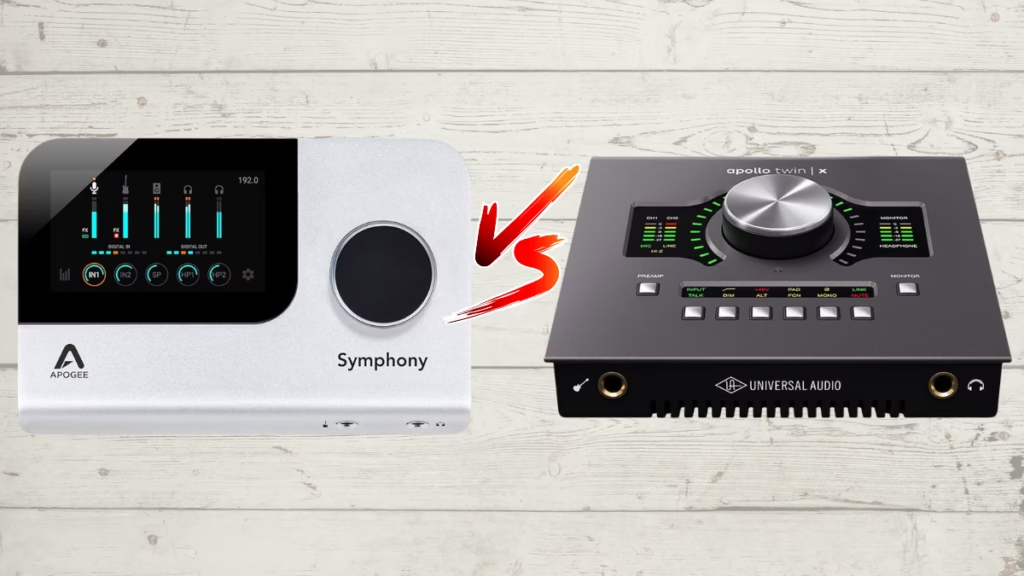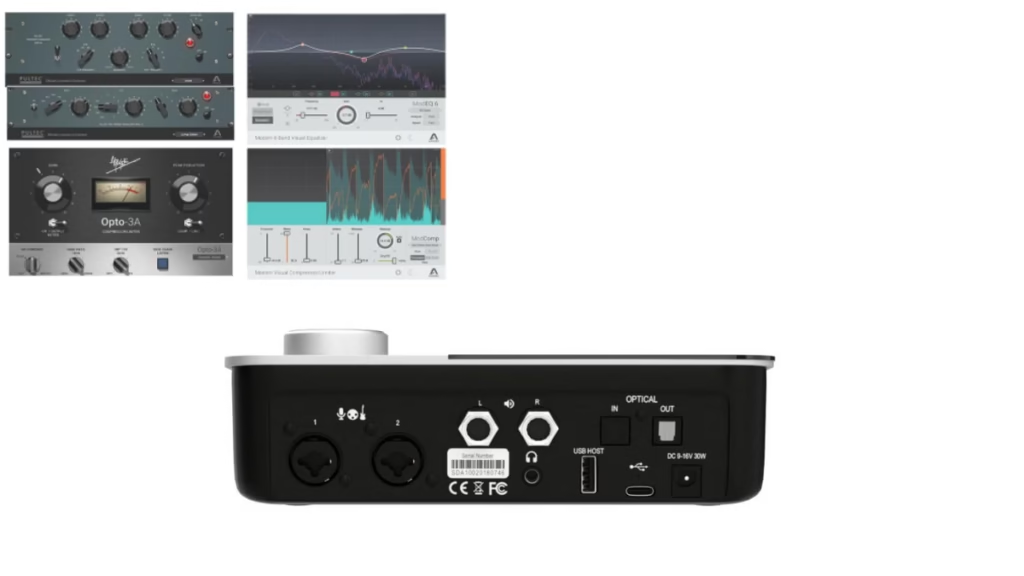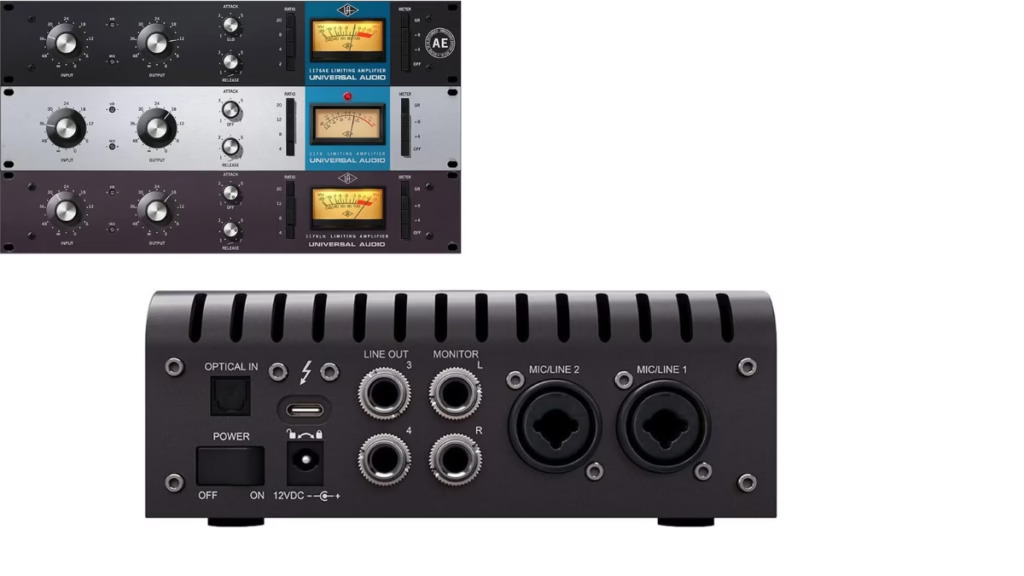How Do Apogee Symphony Desktop and Apollo Twin X Compare ?

Apogee Symphony Desktop vs. Apollo Twin X
In the world of high-end audio interfaces, two names consistently stand out for their pristine sound quality, professional-grade conversion, and reliability: Apogee Symphony Desktop and Universal Audio Apollo Twin X. Both offer exceptional audio performance, but each has its unique strengths and features. This review will compare these two audio interfaces across key specs to help you decide which one best suits your music production needs.
Build Quality and Design
- Apogee Symphony Desktop: The Symphony Desktop is compact and beautifully designed, featuring an all-metal chassis with a sleek, modern aesthetic. Its user interface includes a high-resolution OLED display, which provides easy-to-read information and quick adjustments. The desktop design ensures that it fits well into both home studio setups and professional environments, without taking up too much space.
- Universal Audio Apollo Twin X: The Apollo Twin X has a similar compact form factor with an all-metal build, giving it a solid and durable feel. It features a clean, straightforward layout with a large knob for volume and a small display for monitoring input/output levels. The interface is intuitive, and the front panel controls are highly responsive, making it easy to use in both studio and mobile setups.
Verdict: Both interfaces offer robust builds and sleek designs. However, Apogee Symphony Desktop edges out slightly with its higher-resolution OLED display, which makes it easier to manage settings and monitor performance in real-time.
Audio Quality and Conversion
- Apogee Symphony Desktop: Apogee is known for its high-end AD/DA converters, and the Symphony Desktop is no exception. It features 24-bit/192kHz audio resolution, delivering incredibly clean and transparent sound. The interface’s converters are designed to provide exceptional clarity and low distortion, making it perfect for professionals who require the best possible audio fidelity.
- Universal Audio Apollo Twin X: The Apollo Twin X boasts Universal Audio’s renowned 24-bit/192kHz converters, delivering pristine audio quality and a smooth, natural sound. The converters in the Apollo Twin X offer a warm, analog-style sound, making it a favorite among those who appreciate the analog vibe. With its Unison preamp technology, the Apollo Twin X excels in capturing a range of tones, from crystal-clear to vintage warmth.
Verdict: Both interfaces offer top-tier conversion, but Apogee Symphony Desktop is known for its ultra-transparent, high-definition sound, while the Apollo Twin X provides a warmer, analog-esque flavor that’s ideal for users seeking that analog warmth.
DSP and Plugin Ecosystem
- Apogee Symphony Desktop: The Symphony Desktop features onboard DSP processing, allowing users to run Apogee’s premium plugins with low latency, without taxing your computer’s CPU. However, Apogee does not have as extensive a plugin ecosystem as Universal Audio, limiting the range of third-party options.
- Universal Audio Apollo Twin X: The Apollo Twin X is equipped with powerful onboard DSP and runs Universal Audio’s impressive library of UAD plugins. These plugins include some of the most coveted analog emulations on the market, such as preamp, compressor, and EQ emulations. The Apollo Twin X’s Unison preamp technology provides real-time analog hardware emulations, giving users an intuitive experience with analog warmth and character.
Verdict: Universal Audio Apollo Twin X has a significant advantage in the DSP and plugin department, thanks to its extensive UAD plugin library and Unison preamp technology. If you require a wide range of analog emulations and third-party plugins, the Apollo Twin X is the better choice. The Apogee Symphony Desktop offers DSP, but with fewer plugin options.
Inputs, Outputs, and I/O Options
- Apogee Symphony Desktop: The Symphony Desktop offers two combo XLR/¼” inputs with Apogee’s pristine preamps, along with a headphone output, stereo line outputs, and two additional balanced outputs. It also features USB-C connectivity, ensuring fast and reliable data transfer. While it’s geared toward desktop setups, it can be expanded with additional Apogee products for more I/O options.
- Universal Audio Apollo Twin X: The Apollo Twin X offers two Unison preamp inputs (XLR/¼” combo), a headphone output, two line outputs, and two monitor outs. It also features USB-C connectivity for fast data transfer. Additionally, the Apollo Twin X is part of the larger Apollo ecosystem, meaning you can easily add more I/O by chaining multiple Apollo interfaces together.
Verdict: In terms of I/O, both interfaces offer two preamp inputs, but the Universal Audio Apollo Twin X has a slight edge for future expandability, as it integrates seamlessly with other Apollo devices. The Apogee Symphony Desktop offers fewer expansion options but maintains excellent quality with its built-in features.
Latency and Performance
- Apogee Symphony Desktop: The Symphony Desktop delivers low-latency performance, making it a great option for real-time monitoring and recording. Apogee’s drivers are known for their reliability and low latency, ensuring smooth playback and recording, even with demanding projects.
- Universal Audio Apollo Twin X: Thanks to its onboard DSP, the Apollo Twin X provides ultra-low latency performance for both recording and monitoring. The onboard DSP takes the load off your computer, allowing you to use UAD plugins without affecting your system’s performance, even during demanding sessions.
Verdict: Both interfaces excel in latency performance, with the Universal Audio Apollo Twin X having an edge due to its DSP-powered processing and real-time plugin usage.
Software and Compatibility

- Apogee Symphony Desktop: The Symphony Desktop integrates well with Apogee’s software suite, which includes Maestro for interface control, as well as support for DAWs like Logic Pro, Pro Tools, and others via USB or Thunderbolt. The Apogee Symphony Control software allows users to configure routing, monitoring, and other advanced settings.

- Universal Audio Apollo Twin X: The Apollo Twin X is compatible with a wide range of DAWs and includes the powerful Console application, which controls input routing, DSP management, and Unison preamp settings. It also integrates seamlessly with UAD plugins, which can be used in both real-time and offline processing modes.
Verdict: Both interfaces have excellent software suites, but Universal Audio Apollo Twin X has the advantage of seamless integration with its UAD plugin ecosystem and Console software, making it a more feature-rich solution for users heavily invested in UAD plugins.
Price and Value
- Apogee Symphony Desktop: The Symphony Desktop is positioned as a high-end audio interface, offering professional-grade conversion and DSP in a compact form. While it is slightly less expensive than the Apollo Twin X, it does not offer the same plugin ecosystem or analog emulation capabilities, which may affect its value for users seeking a comprehensive studio solution.
- Universal Audio Apollo Twin X: The Apollo Twin X is similarly priced, but its expansive UAD plugin ecosystem and Unison preamp technology add significant value, particularly for producers and engineers who need analog emulations. For those looking for a highly flexible, plugin-rich environment, the Apollo Twin X provides more bang for your buck.
Verdict: Both interfaces offer great value for professional users, but the Universal Audio Apollo Twin X offers more in terms of plugin options and DSP power for the price, making it a better choice for users who need a broader range of tools for their production.
Pros and Cons
Apogee Symphony Desktop
- Pros:
- Exceptional sound quality and transparent conversion.
- High-quality preamps with low distortion.
- Low-latency performance.
- Compact and modern design.
- Cons:
- Limited DSP power and fewer plugin options compared to the Apollo Twin X.
- Fewer I/O options for expanding setups.
Universal Audio Apollo Twin X
- Pros:
- Industry-leading UAD plugin ecosystem and real-time analog emulations via Unison technology.
- Powerful onboard DSP for low-latency, real-time processing.
- Seamless integration with other Apollo interfaces.
- Warm analog-style conversion.
- Cons:
- Slightly warmer sound that may not be suitable for users seeking absolute transparency.
- Higher price point when considering the additional cost of UAD plugins.
Conclusion
The Apogee Symphony Desktop and Universal Audio Apollo Twin X are both outstanding audio interfaces, each catering to different user needs.
- Apogee Symphony Desktop is perfect for those who need ultra-transparent audio conversion, professional-grade preamps, and compact design without the need for an extensive plugin library.
- Universal Audio Apollo Twin X is the ideal choice for users who want real-time analog emulation, access to a vast library of UAD plugins, and powerful DSP processing, especially for music production in genres that benefit from vintage analog warmth.
Ultimately, your choice will depend on your preference for sound quality (transparent vs. analog warmth) and the importance of UAD plugins and expandability.
